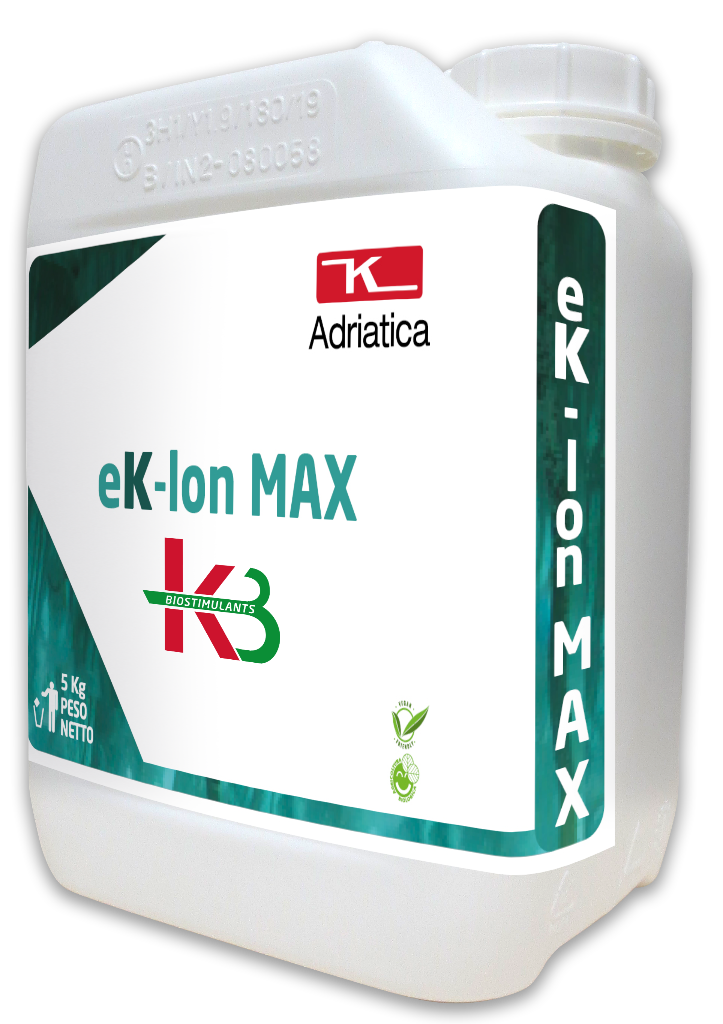

Packaging 5 kg
PHYSIOLOGICAL ACTIVATORS
eK-lon MAX
IMPROVES STRESS RESISTANCE
ENHANCES PHOTOSYNTHESIS
IMPROVES YIELDS
eK-lon MAX is a 100% natural liquid biostimulant made exclusively from the fronds of Ecklonia maxima, a brown seaweed harvested in low-pollution areas. It contains approximately 30% seaweed extract, equivalent to a 3% dry matter content, and is produced through a low-temperature physical process that preserves the integrity and functionality of all its bioactive components. Key constituents include alginic acid, a polysaccharide with chelating properties that enhances the plant's ability to retain water and nutrients, boosting tolerance to water stress, as well as fucoidans and laminarins, bioactive molecules that stimulate the plant's natural defense mechanisms, increasing resilience to abiotic stress. Additionally, betaine acts as an osmoprotectant, regulating water balance and protecting plant cells from damage caused by adverse environmental conditions. eK-lon MAX is characterized by a unique hormone-like profile, with an auxin-to-cytokinin ratio of 10:1, as confirmed by bioassays. This balance stimulates uniform growth, promoting root system development, improving nutrient uptake, and enhancing the plant's photosynthetic capacity. Altogether, these effects contribute to a significant increase in yield.
Fully approved for use in organic farming, eK-lon MAX meets the highest sustainability standards, offering an innovative solution to enhance crop quality and resilience
CE BIOSTIMULANT CERTIFIED BY AGENCY CODE. NANDO 2832 WITH N° CERT.: DE.3762-3763
| Culture | Time of application | Dose fogliare* | Fertigation dose* |
|---|---|---|---|
| Fruiting vegetables (Pumpkin, Zucchini, Tomato, Pepper, Melon, Eggplant, Cucumber, Watermelon) | In the nursery: apply on the seedlings once a week for 2-3 times, soak the seedling tray in a 1: 100 solution before transplanting In the field: starting from 15 days after the transplanting, 2-4 applications at intervals of 15 days |
200-300 g/hl | 3-6 kg |
| Other vegetables (Leek, Fennel, Onion, Cauliflower, Cabbage, Carrot, Broccoli, Garlic) | In the nursery: apply on the seedlings once a week for 2-3 times, soak the seedling tray in a 1: 100 solution before transplanting In the field: starting from 15 days after the transplanting, 2-4 applications at intervals of 15 days |
200-300 g/hl | 3-6 kg |
| Leafy vegetables (Spinach, Celery, Escarole, Rocket, Radicchio, Lettuce, Chicory) | In the nursery: apply on the seedlings once a week for 2-3 times, soak the seedling tray in a 1: 100 solution before transplanting In the field: starting from 15 days after the transplanting, 2-4 applications at intervals of 15 days |
200-300 g/hl | 3-6 kg |
| Olive e Grapes | 3 applications: buds of 5-10 cm, pre-flowering, grape/drupe of 4-6 mm diameter | 300-400 g/hl | 4-8 kg |
| Kiwifruit | 3-4 applications: from pre-flowering, to be repeated every 15 days | 300-400 g/hl | 4-8 kg |
| Citrus (Tangerine, Lemon, Clementine, Bergamot, Orange) | 3-4 applications: from pre-flowering, to be repeated every 10-14 days | 300-400 g/hl | 4-8 kg |
| Pome fruits (Quince, Apple, Pear) | Pre-flowering, petals' fall, fruit enlargement starting from 20 mm diameter: applications every 10-15 days | 300-400 g/hl | 4-8 kg |
| Stone fruits (Peach, Nectarine, Cherry, Apricot, Plum) | 4-6 applications: from flowering to veraison (change of color), every 15 days | 300-400 g/hl | 4-8 kg |
| Strawberries | Soak the seedlings in a 1: 100 solution before transplanting From the beginning of flowering: 2-3 applications at intervals of 15-20 days | 300-400 g/hl | 4-8 kg |
| Nut fruits | From flowering of the female inflorescence: 3-5 applications every 15 days | 300-400 g/hl | 4-8 kg |
| Legumes (Bean, Lentil, Pea) | 4 applications: 3 to 5 leaves, pre-flowering, full flowering and at pod's development | 200-300 g/hl | 3-6 kg |
| Small fruits (Raspberry, Blueberry, Blackberry, Currant) | From pre-flowering, 3-4 applications to be repeated every 7-10 days | 200-300 g/hl | 3-6 kg |
-
Fruiting vegetables (Pumpkin, Zucchini, Tomato, Pepper, Melon, Eggplant, Cucumber, Watermelon)200-300 g/hl3-6 kgIn the nursery: apply on the seedlings once a week for 2-3 times, soak the seedling tray in a 1: 100 solution before transplanting
In the field: starting from 15 days after the transplanting, 2-4 applications at intervals of 15 days -
Other vegetables (Leek, Fennel, Onion, Cauliflower, Cabbage, Carrot, Broccoli, Garlic)200-300 g/hl3-6 kgIn the nursery: apply on the seedlings once a week for 2-3 times, soak the seedling tray in a 1: 100 solution before transplanting
In the field: starting from 15 days after the transplanting, 2-4 applications at intervals of 15 days -
Leafy vegetables (Spinach, Celery, Escarole, Rocket, Radicchio, Lettuce, Chicory)200-300 g/hl3-6 kgIn the nursery: apply on the seedlings once a week for 2-3 times, soak the seedling tray in a 1: 100 solution before transplanting
In the field: starting from 15 days after the transplanting, 2-4 applications at intervals of 15 days -
Olive e Grapes300-400 g/hl4-8 kg3 applications: buds of 5-10 cm, pre-flowering, grape/drupe of 4-6 mm diameter
-
Kiwifruit300-400 g/hl4-8 kg3-4 applications: from pre-flowering, to be repeated every 15 days
-
Citrus (Tangerine, Lemon, Clementine, Bergamot, Orange)300-400 g/hl4-8 kg3-4 applications: from pre-flowering, to be repeated every 10-14 days
-
Pome fruits (Quince, Apple, Pear)300-400 g/hl4-8 kgPre-flowering, petals' fall, fruit enlargement starting from 20 mm diameter: applications every 10-15 days
-
Stone fruits (Peach, Nectarine, Cherry, Apricot, Plum)300-400 g/hl4-8 kg4-6 applications: from flowering to veraison (change of color), every 15 days
-
Strawberries300-400 g/hl4-8 kgSoak the seedlings in a 1: 100 solution before transplanting From the beginning of flowering: 2-3 applications at intervals of 15-20 days
-
Nut fruits300-400 g/hl4-8 kgFrom flowering of the female inflorescence: 3-5 applications every 15 days
-
Legumes (Bean, Lentil, Pea)200-300 g/hl3-6 kg4 applications: 3 to 5 leaves, pre-flowering, full flowering and at pod's development
-
Small fruits (Raspberry, Blueberry, Blackberry, Currant)200-300 g/hl3-6 kgFrom pre-flowering, 3-4 applications to be repeated every 7-10 days
In the case of different volumes, for use with low-volume or volume recovery sprayers, where, for proper wetting of the vegetation, a smaller quantity of water than the Normal Volumes (VN) may be sufficient, it is suggested to refer to the dose of 200-400 gr per hectolitre (gr/hL).






